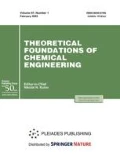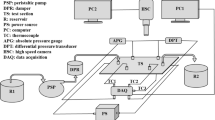Abstract
Nonuniform performance of the parallel channels of the microchannel heat sink is one of the major limitations aggravating many undesired influences in both the single phase and the two phase heat transfer in microchannel heat sink. The nonuniform performance of the channels is preliminarily governed by the nonuniformity of the mass flow rate and heat flux transferred from the interface of parallel microchannels. The poor heat transfer (adiabatic/natural convection) boundary condition is primarily responsible for heat flux nonuniformity. In the current study a novel design of parallel microchannels heat sink is proposed, which is obtained by decreasing nonuniformity of mass flow rate and heat transfer existing between parallel channels of the microchannel heat sink. The nonuniformity of the mass flow rate is removed by the existing variable width approach and heat transfer nonuniformity among parallel channels is solved by the newly developed slanted microchannel provision. Developed design normalizes flow nonuniformity by 95.5% and heat transfer nonuniformity by 97.5% in comparison to the conventional design microchannel heat sink. The two major benefits offered by the proposed design are cooled (4.2 K lower than the conventional design) and uniform (3.1 K lesser than the conventional design) base surface temperature. It is also found that proposed work even facilitated in reduction of average base temperature (1.3 K lower than the conventional design). The maximum improvement in Nusselt number is 4.07%, also the proposed design extends benefits at off-design conditions even.











Similar content being viewed by others
REFERENCES
Tuckerman, D.B. and Pease, R.F.W., High-performance heat sinking for VLSI, IEEE Electron Device Lett., 1981, vol. 2, p. 126.
Adham, A.M., Mohd-ghazali, N., and Ahmad R., Thermal and hydrodynamic analysis of microchannel heat sinks: A review, Renewable Sustainable Energy Rev., 2013, vol. 21, p. 614. https://doi.org/10.1016/j.rser.2013.01.022
Dewan, A. and Srivastava, P., A review of heat transfer enhancement through flow disruption in a microchannel, J. Therm. Sci., 2015, vol. 24, p. 203. https://doi.org/10.1007/s11630-015-0775-1
Rosa, P., Karayiannis, T.G., and Collins, M.W., Single-phase heat transfer in microchannels: The importance of scaling effects, Appl. Therm. Eng., 2009, vol. 29, p. 3447. https://doi.org/10.1016/j.applthermaleng.2009.05.015
Tullius, J.F., Vajtai, R., and Bayazitoglu, Y., A review of cooling in microchannels, Heat Transfer Eng., 2011, vol. 32, p. 527. https://doi.org/10.1080/01457632.2010.506390
Kadam, S.T. and Kumar, R., Twenty first century cooling solution: Microchannel heat sinks, Int. J. Therm. Sci., 2014, vol. 85, p. 73. https://doi.org/10.1016/j.ijthermalsci.2014.06.013
Lu, M. and Wang, C., Effect of the inlet location on the performance of parallel-channel cold-plate, IEEE Trans. Compon. Packag. Technol., 2006, vol. 29, p. 30.
Hetsroni, G., Mosyak, A., and Segal, Z., Nonuniform temperature distribution in electronic devices cooled by flow in parallel microchannels, IEEE Trans. Compon. Packag. Technol., 2001, vol. 24, p. 16.
Chein, R. and Chen, J., Numerical study of the inlet/outlet arrangement effect on microchannel heat sink performance, Int. J. Therm. Sci., 2009, vol. 48, p. 1627. https://doi.org/10.1016/j.ijthermalsci.2008.12.019
Dharaiya, V.V., Radhakrishnan, A., and Kandlikar, S.G., Evaluation of a tapered header configuration to reduce flow maldistribution in minichannels and microchannels, ASME 2009 7th Int. Conf. Nanochannels, Microchannels and Minichannels, 2009, p. 771. https://doi.org/10.1115/ICNMM2009-82288
Kumaran, R.M., Kumaraguruparan, G., and Sornakumar, T., Experimental and numerical studies of header design and inlet / outlet configurations on flow mal-distribution in parallel micro-channels, Appl. Therm. Eng., 2013, vol. 58, p. 205. https://doi.org/10.1016/j.applthermaleng.2013.04.026
Xia, G.D., Jiang, J., Wang, J., Zhai, Y.L., and Ma, D.D., Effects of different geometric structures on fluid flow and heat transfer performance in microchannel heat sinks, Int. J. Heat Mass Transfer, 2015, vol. 80, p. 439. https://doi.org/10.1016/j.ijheatmasstransfer.2014.08.095
Minqiang, P., Dehuai, Z., Yong, T., and Dongqing, C., CFD-based study of velocity distribution among multiple parallel microchannels, J. Comput., 2009, vol. 4, p. 1133.
Kumaraguruparan, G., Kumaran, R.M., Sornakumar, T., and Sundararajan, T., A numerical and experimental investigation of flow maldistribution in a micro-channel heat sink, Int. Commun. Heat Mass Transfer, 2011, vol. 38, p. 1349. https://doi.org/10.1016/j.icheatmasstransfer.2011.08.020
Yadav, V., Kumar, R., and Narain, A., Mitigation of flow maldistribution in parallel microchannel heat sink, IEEE Trans. Compon., Packag., Manuf. Technol., 2019, vol. 9, p. 247. https://doi.org/10.1109/TCPMT.2018.2851543
Weisberg, A., Bau, H.H., and Zemel, J.N., Analysis of microchannels for integrated cooling, Int. J. Heat Mass Transfer, 1992, vol. 35, p. 2465.
Hung, T. and Yan, W., Effects of tapered-channel design on thermal performance of microchannel heat sink, Int. Commun. Heat Mass Transfer, 2012, vol. 39, p. 1342. https://doi.org/10.1016/j.icheatmasstransfer.2012.08.008
Dehghan, M., Daneshipour, M., Valipour, M.S., Rafee, R., and Saedodin, S., Enhancing heat transfer in microchannel heat sinks using converging flow passages, Energy Convers. Manage., 2015, vol. 92, p. 244. https://doi.org/10.1016/j.enconman.2014.12.063
Duryodhan, V.S., Singh, A., Singh, S.G., and Agrawal, A., A simple and novel way of maintaining constant wall temperature in microdevices, Sci. Rep., 2016, vol. 6, p. 18230. https://doi.org/10.1038/srep18230
Riera, S., Barrau, J., Omri, M., Frechette, L.G., and Rosell, J.I., Stepwise varying width microchannel cooling device for uniform wall temperature: Experimental and numerical study, Appl. Therm. Eng., 2015, vol. 78, p. 30. https://doi.org/10.1016/j.applthermaleng.2014.12.012
Kumar, R., Singh, G., and Mikielewicz, D., A new approach for the mitigating of flow maldistribution in parallel microchannel heat sink, J. Heat Transfer, 2018, vol. 140, p. 072401. https://doi.org/10.1115/1.4038830
Koo, J. and Kleinstreuer, C., Liquid flow in microchannels: Experimental observations and computational analyses of microfluidics effects, J. Micromech. Microeng., 2003, vol. 13, p. 568.
Qu, W.L. and Mudawar, I., Experimental and numerical study of pressure drop and heat transfer in a single-phase micro-channel heat sink, Int. J. Heat Mass Transfer, 2002, vol. 45, p. 2549.
Patankar, S.V., Numerical Heat Transfer and Fluid Flow, Washington, DC: Hemisphere, 1980.
Phillips, R.J., Microchannel heat sinks, PhD Thesis, Cambridge, Mass.: Massachusetts Inst. of Technology, 1987.
Shah, R.K. and London, A.L., Laminar Flow Forced Convection in Ducts, New York: Academic, 1978.
Lee, P.S. and Garimella, S.V., Thermally developing flow and heat transfer in rectangular microchannels of different aspect ratios, Int. J. Heat Mass Transfer, 2006, vol. 49, p. 3060. https://doi.org/10.1016/j.ijheatmasstransfer.2006.02.011
Funding
The authors acknowledge financial help provided by the Department of Science and Technology (DST) in India under the project INT/RUS/RFBR/350 and the Russian Foundation of Basic Research (RFBR) in Russia under the project 18-58-45014IND_a' for supporting our current work.
Author information
Authors and Affiliations
Corresponding author
Additional information
Special issue: “Two-phase flows in microchannels: hydrodynamics, heat and mass transfer, chemical reactions”. Edited by R.Sh. Abiev
Rights and permissions
About this article
Cite this article
Kumar, R., Yadav, V. & Abiev, R.S. Concurrent Removal of Heat Transfer and Mass Flow Rate Nonuniformities in Parallel Channels of Microchannel Heat Sink. Theor Found Chem Eng 54, 77–90 (2020). https://doi.org/10.1134/S004057952001011X
Received:
Revised:
Accepted:
Published:
Issue Date:
DOI: https://doi.org/10.1134/S004057952001011X




